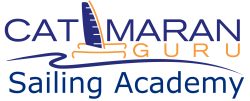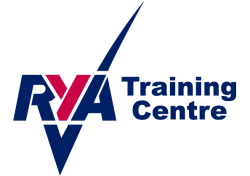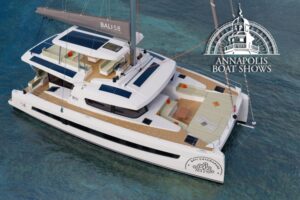Cruising Catamaran (ASA 114)
Prerequisites: Basic Keelboat (101) and Basic Coastal Cruising (103). The Bareboat Charter Standard (104) is also a prerequisite and can be attained either prior to or in conjunction with Bareboat Charter (BBC) Multihull (114). In either case, ALL MATERIAL IN BOTH ASA STANDARDS (104 & 114) MUST BE TAUGHT AND TESTED BEFORE ASA 114 CERTIFICATION CAN BE AWARDED.
General Description: An advanced cruising standard for individuals with cruising experience. The individual can act as skipper and crew of a 30 – 50 foot multihull sailboat by day in coastal waters. The standard includes those skills unique to a 30 – 50 foot multihull.
Sailing Knowledge
Identify and describe the following hardware terms:
- Bridgedeck cabin three-point rig
- Bridle-line catamaran crossarms
- Float Full wing deck open wing deck
- Partial wing deck galley down galley up
- Hull(s) main hull multihull
- Safety nets – seagull striker and dolphin striker
- Discuss the advantages and disadvantages to operating a multihull sailboat.
- Describe the weight-carrying characteristics of 30 – 50 foot cruising multihulls and how weight distribution affects safety and performance.
- Describe the differences in performance between multihulls and monohulls of similar size.
- Describe the accommodations of a typical 30 -50 foot multihull and how comfort and safety will differ from a monohull.
- Identify differences between ships’ systems between multihulls and monohulls.
- Describe shoal draft and its effect on planning ahead and sailing.
- Describe the danger of capsizing, how to recognize the danger, and how to prevent it.
- Discuss the characteristics of a multihull which determine windage and the effects of windage on course and speed.
- Discuss how multihull design affects turning radius.
- Describe a typical center/daggerboard installation on a multihull and how they affect performance.
- Describe options for gear stowage and proper stowing procedures.
- Describe how and where a safety harness would attach to a multihull.
- Discuss the various sail combinations and how they affect balance of a multihull.
Discuss the differences of multihull heavy weather sailing practices (advantages and disadvantages) over monohull including the following:
- Lying a-hull heaving-to
- Sea anchors
- Describe and discuss the methods of rafting multihulls and the limitations involved
- Discuss the limitations of a multihull galley and methods of working safely in the galley.
- Discuss auxiliary power options on a multihull.
- Discuss engine placement on a multihull and its effect on performance and safety.
- Discuss common mechanical maintenance on a multihull.
- Discuss common mechanical repairs on a multihull.
- Describe and discuss what to do if one or both engines fail.
- Describe options for carrying and towing a dinghy.
- Describe the method of tying a multihull securely to a dock in areas of varying tidal range.
Boat Handling Under Power
- Cast off and safely leave a dock with at least two different wind directions relative to the bow.
- Stop the bow of the boat within four feet of a marker while maneuvering under power. Perform the exercise upwind, downwind and with the wind across the beam.
- Maneuver the boat under power in a confined space noting the effects of wind and current.
- Maneuver the boat within 2 feet of, and parallel to, a dock. Define and carry out a bail-out plan.
- Turn the boat in the tightest possible circle to determine its turning radius. Twin screw boats will perform the exercise with screws turning in opposite directions and again with screws turning in the same direction.
- Repeat item 29 turning the boat in the opposite direction and compare the differences between both turns.
- Repeat items 29 and 30 while making sternway.
- Steer a straight course of at least 10 boat lengths in reverse using moderate speed.
- If the boat has twin engines, repeat items 30 & 31 using one engine and then the other.
- Steer a multihull using an emergency steering device.
Crew Overboard
- Demonstrate a skipper’s actions and commands while under power from the time a crew member falls overboard until crew is safely recovered.
- Describe at least two methods of getting a person out of the water and back on board a multihull.
Boat Handling Under Sail
Points of Sail
- Function as helmsman and crew giving correct commands and proper responses while demonstrating the proper techniques of close-hauled sailing, reaching (all three points), running, tacking and jibing, heading up, bearing away and luffing while noting the differences and likenesses of sailing a multihull vs. monohull.
- Sail an ordered compass course for 5 minutes without varying more than 10 degrees from the heading.
- Sail a figure-8 course between two buoys noting acceleration/deceleration times and momentum during turns.
- While sailing at full power, luff sails and observe how long it takes for a multihull to come to rest.
- Trim luffing sails noting how long it takes to accelerate to full power.
Crew Overboard
- Demonstrate a skipper’s actions and commands for man overboard while under sail from the time a crew member falls overboard until crew is safely recovered, use two different return techniques including the quick-stop method.
- Heavy Weather
- Reduce sail by reefing and shake out a reef while keeping the vessel under control and on course.
- Heave-to and get underway again, noting the vessels motion at different angles to the wind.
- Sail with the mainsail only, then headsail only noting performance characteristics and limitations.
Anchoring
- Use proper anchoring techniques to anchor using the following methods:
- Two anchors off bow and stern (Bahamian moor)
- Single bow anchor and bridle
- Single bow anchor and stern to beach (Med style)
- Bow to a permanent mooring with bridle (if available)
- Beaching with consideration of daggerboard/centerboard, rudder, and hull-mounted electronics. (optional)
- Making fast and snugging down
- Secure a boat to various dock configurations so as to provide limited movement and set out fenders correctly.
- Take extra precautions to secure a vessel for the night at a dock and at a mooring.
Sail With Us to Learn


Week-Long Liveaboard Courses
Rare RYA Classes & Certifications
Catamaran Guru’s real-life practical methods combined with up-to-date sailing theory in lessons aboard recent model catamarans…or your own boat!
Prepare for certifications or take the first step aboard to embark on your dream life of boat ownership or cruising
Classes in S Florida and the Bahamas.







2 thoughts on “ASA 114 – Cruising Catamaran Certification”
What do you charge for ASA 114 and where are the classes available
Hi Paul, email me estelle@catamaranguru.com. I will direct you to the various entities that can do sailing schools for you.